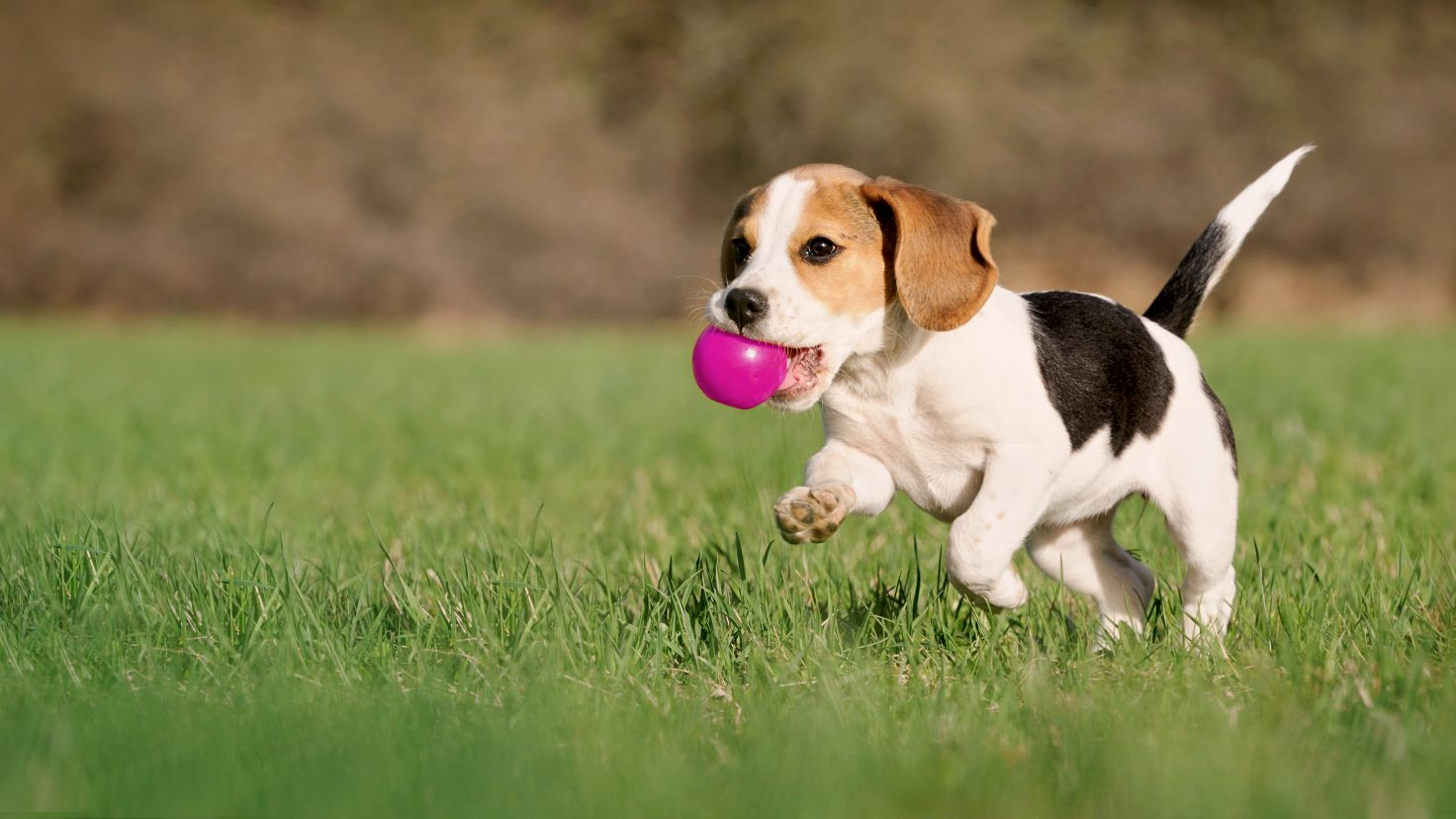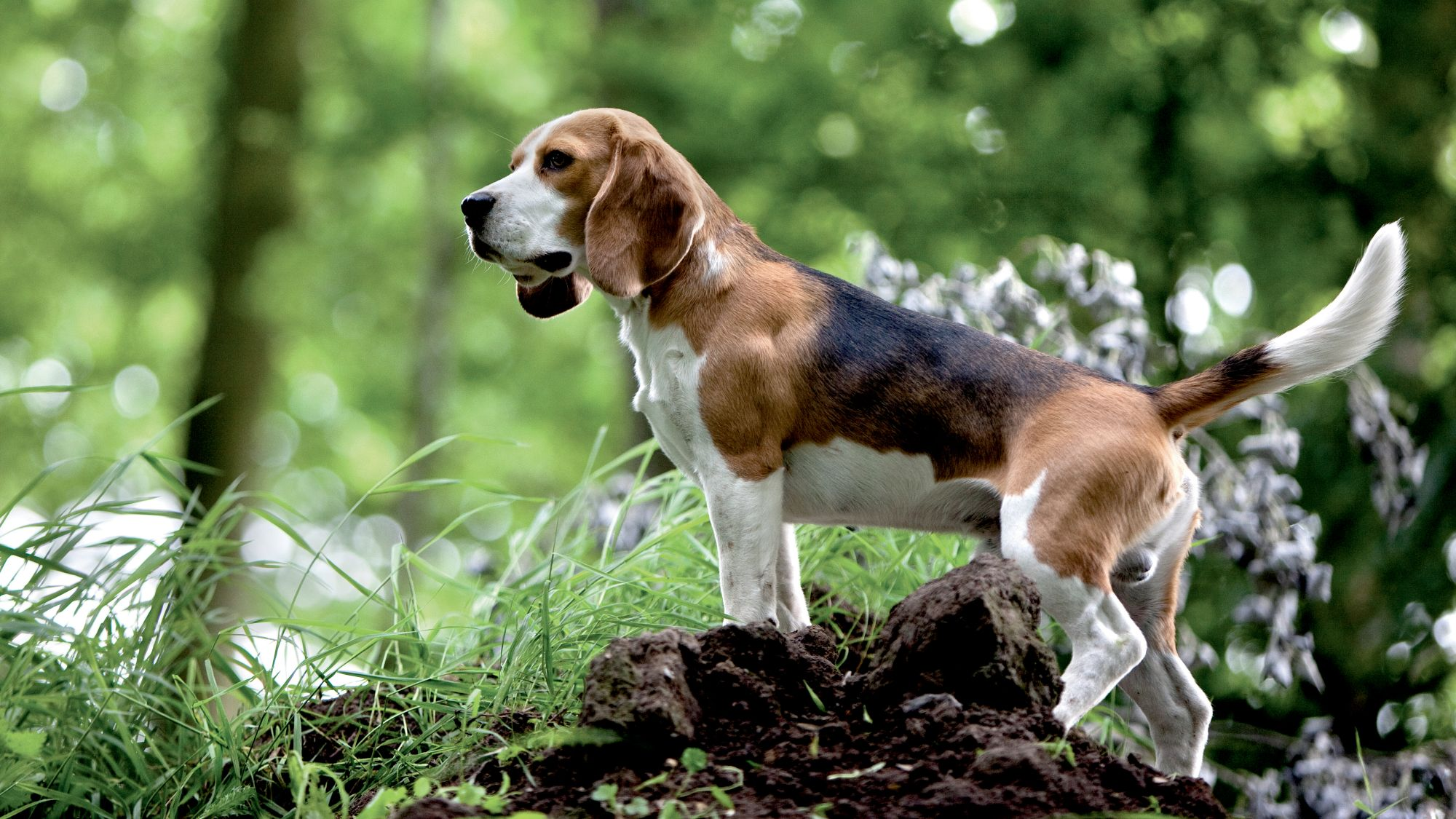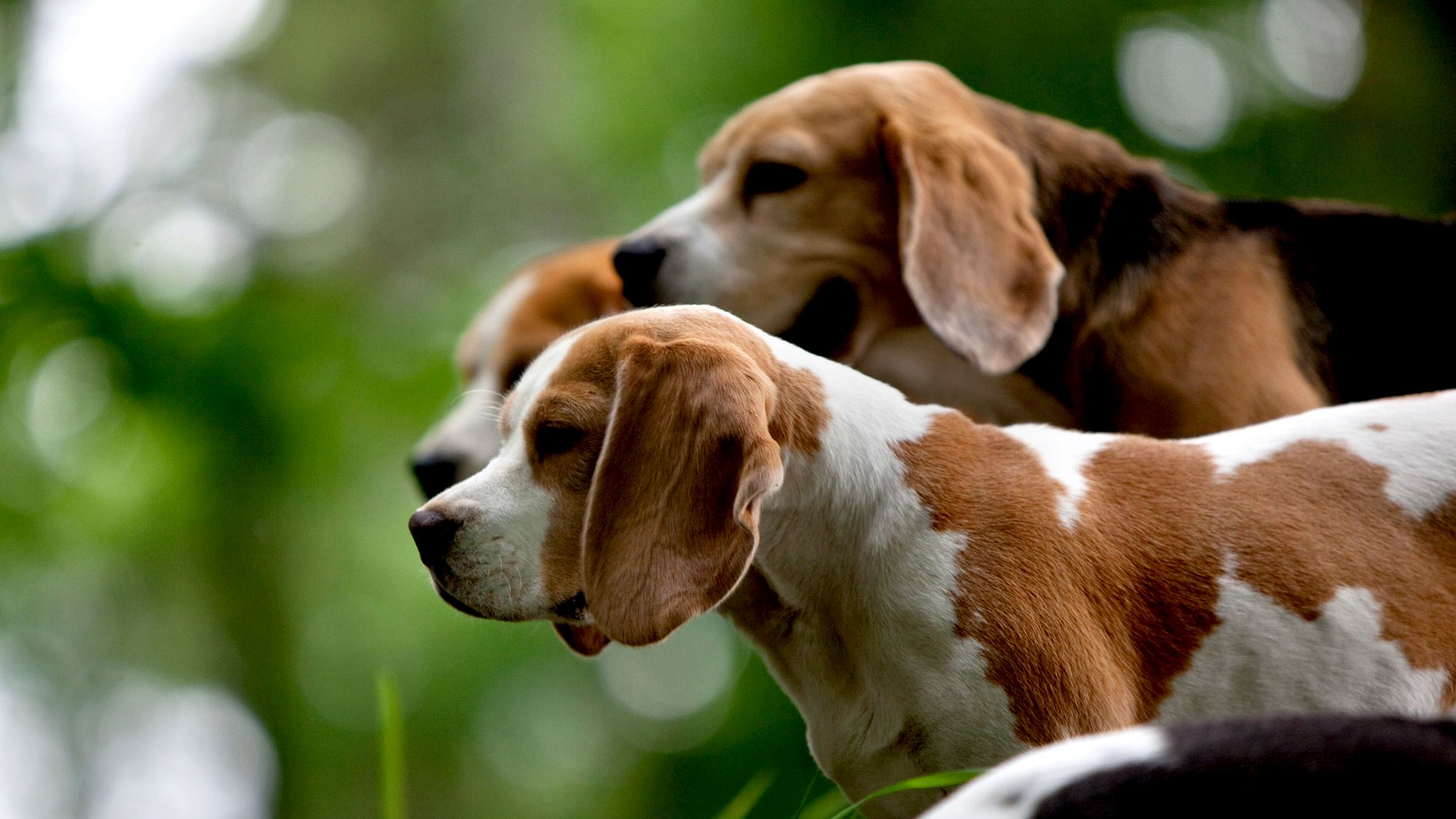Let's talk Beagles
Among the world’s most popular dogs, Beagles are loyal, affectionate, and intelligent animals. With their big brown eyes, floppy ears, and ‘pleading’ expression, these handsome hounds are also hard to resist. Their background as hunting animals can make training a bit of a challenge. Also, they tend to bark more than average, but the Beagle breed is absolutely worth the extra effort. With a bit of time and patience, you’ll have the perfect companion.
Official name: Beagle
Other names: Hound, English Beagle
Origins: United Kingdom
Drooling tendencies
2 out of 5Grooming needs
1 out of 5Shedding Level
3 out of 5Barking tendencies
5 out of 5Energy level
3 out of 5Compatibility with other pets
4 out of 5Warm weather?
3 out of 5Cold weather?
2 out of 5Suited to apartment living
3 out of 5Can be left alone
1 out of 5Family pet
4 out of 5
| Male | Female |
|---|---|
| Height | Height |
| 33 - 38 cm | 28 - 38 cm |
| Weight | Weight |
| 9.1 - 11.3 kg | 9.1 - 10.4 kg |
| Life Stage | |
|---|---|
| Puppy | Adult |
| 2 to 12 months | 12 months to 7 years |
| Mature | Senior |
| 7 to 10 years | 10 to 20 years |
| Baby | |
| Birth to 2 months | |
Drooling tendencies
2 out of 5Grooming needs
1 out of 5Shedding Level
3 out of 5Barking tendencies
5 out of 5Energy level
3 out of 5Compatibility with other pets
4 out of 5Warm weather?
3 out of 5Cold weather?
2 out of 5Suited to apartment living
3 out of 5Can be left alone
1 out of 5Family pet
4 out of 5
| Male | Female |
|---|---|
| Height | Height |
| 33 - 38 cm | 28 - 38 cm |
| Weight | Weight |
| 9.1 - 11.3 kg | 9.1 - 10.4 kg |
| Life Stage | |
|---|---|
| Puppy | Adult |
| 2 to 12 months | 12 months to 7 years |
| Mature | Senior |
| 7 to 10 years | 10 to 20 years |
| Baby | |
| Birth to 2 months | |

Get to know the Beagle
All you need to know about the breed
Although the origins of the Beagle are not precisely known, they are thought to have been with us for many hundreds of years. Believed to descend originally from the hunting hounds of the Romans, they became popular in Britain during the 1800s. In 1890, The Beagle Club was established, and the breed standard followed soon after.
Today, the Beagle is one of the top 10 most popular dogs in the world, according to the American Kennel Club. Their russet, black, and white coat is similar in appearance to the Foxhound- though the latter is much larger. The American Kennel Club distinguishes two varieties of Beagle, those under 13 inches at the shoulder and those between 13 and 15 inches- they can be slightly larger in the UK.
The Beagle is a healthy breed of dog with a good lifespan, living well into their teens- and occasionally even beyond.
Active and energetic, Beagles require at least an hour of exercise every day, but ideally more. Bred to hunt in packs, they do better with company and are not good at being left alone.
One other word of warning before choosing a Beagle: they are known to bark and bay quite frequently and tend to be a bit more challenging to train than some breeds, but nothing that can't be overcome with a few treats and a bit of patience.
Overall, these faithful animals make marvellous companions. In fact, with a bit of effort invested, you'll soon be rewarded with a new best friend.

Two facts about Beagles
1. On the scent
The Beagle has one of the best senses of smell out of all dog breeds. In fact, they have around 220 scent receptors in their nose³.
2. All in a day’s work
The Beagle's incredible sense of smell makes them a great choice for sniffer dogs where they are trained to sniff out explosives and narcotics. However, in recent years, they have also learned to detect coronavirus through smell.
History of the breed
Despite various opinions among dog lovers, the origins of the Beagle remain somewhat a mystery. Even though they probably descended from Roman hunting dogs that were used to catch rabbits and similar game, they also appeared in paintings and literature that dates back all the way to the Elizabethan times.
Back then, there were smaller, Wire-Haired Beagles—some of which were so small they could be carried in the pocket of a hunting jacket. The size of the Beagle has increased over the years, but smaller versions of the breed, known as “Pocket Beagles,” still exist today.
While the exact origins of the Beagle name are lost to time, many believe the word derives from the Gaelic term “beag” (little). Others suggest it comes from the French term for the blast of hunting horns (“bégeule”).
In any event, the modern breed of Beagle is thought to have emerged in Great Britain around the 1830s. Believed to be a cross between several breeds—including possibly the Talbot Hound, the North Country Beagle, and the Southern Hound—the Beagle's personality seems to have a mixture that includes all the best features of each.
In 1890, the Beagle Club was founded in the UK, and the breed standard followed soon after. Today, the Beagle regularly appears in lists of favourite breeds all over the world.
From head to tail
Physical characteristics of Beagles
1.Head
2.Face
3.Fur
4.Body
5.Tail

Things to look out for
From specific breed traits to a general health overview, here are some interesting facts about your Beagle
It is important to choose an approved breeder
While the Beagle typically has a good lifespan, with an average life expectancy of 12 to 15 years, they can be prone to some genetic health conditions—like all dog breeds. As always, the key is to buy from a responsible and reputable breeder, as they will screen for most inherited conditions, which helps reduce the risks. Additionally, knowing if your Beagle is a carrier or could potentially develop a health issue, later on, can help you and your vet plan accordingly for their lifelong care.
Watch out for eye problems
The Beagle dog breed can also be prone to a few eye issues, such as glaucoma, retinal atrophy (PRA), and a condition called "cherry eye," in which a gland starts to protrude in the corner of the eye. As is often the case with these conditions, early detection can make all the difference. With that in mind, it's important to check your Beagle’s eyes regularly and consult your vet if there are any unusual symptoms or signs of discomfort. Additionally, a comprehensive ophthalmic examination is recommended for your Beagle twice a year.
They are susceptible to epilepsy
Triggered by abnormal electrical activity in the brain, this neurological condition can result in mild or sometimes severe seizures. Other symptoms may include staggering, falling over, or temporary disorientation. One of the more common conditions seen in Beagles, these episodes can start to occur from around six months old. While seizures can be worrying to witness, they often look worse than they really are. In fact, the long-term prognosis for dogs suffering from epilepsy is usually quite positive. As always, it’s best to discuss this with your vet, who will be able to recommend a suitable course of medication for your Beagle.
Tailored nutrition for Beagles

When choosing food for a Beagle, there are many factors to consider: their age, lifestyle, activity level, physical condition, and health, including potential illnesses or sensitivities. Food provides energy to support a dog’s immune system and other vital functions. Additionally, a complete nutritional formula should contain a balanced mix of nutrients to avoid any deficiencies or excesses in their diet, both of which could have adverse effects.
In hot weather, and especially during exercise, clean, fresh water should be available at all times. Energy intake should always be adapted to the climatic conditions. A dog that lives outdoors in winter will have increased energy requirements.
Strong Immune System
Supports the development of the puppy's healthy immune system with the inclusion of clinically proven antioxidants, including Vitamins E and C.
Brain Development
Enriched with DHA, an omega-3 fatty acid that is scientifically proven to support the puppy's brain development.
Microbiome Support
Combination of prebiotics & highly digestible proteins to help promote a healthy balance of intestinal bacteria for digestive health.

The main nutritional goals for adult Beagles are:
Ideal Weight
Beagles are cheerful dogs, bred originally for tracking hares by scent. They are even-tempered, intelligent and determined. All these qualities make the Beagle an excellent companion. They are also known for being voracious eaters, therefore having a tendency to put on weight. This formula helps maintain the adult Beagle’s ideal weight with an appropriate calorie content.
Bone & Joint Support
Beagles are little athletes with stamina and energy to spare. Their sturdy and compact body combined with their natural tendency to put on weight are factors that can put stress on their joints. The Beagle Adult formula includes glucosamine and chondroitin to help support healthy bones and joints. Enriched with EPA and DHA.
Food Intake Control
The exclusive kibble shape helps slow down the rate of food intake by encouraging chewing. This formula also contains an exclusive blend of fibres to help the Beagle feel full after mealtime.
Exclusive Kibble
The kibble texture and formula are designed to encourage
the Beagle to eat slowly, increasing mealtime.

After 7 years old, Beagles begin to show the first signs of aging. A formula enriched with antioxidants will help maintain their energy, while specific nutrients like chondroitin and glucosamine will support healthy bones and joints. Aging also brings changes in digestive abilities and specific nutritional needs, so food for older Beagles should have the following characteristics:
Body Condition
Helps maintain ideal weight and muscle mass with optimal levels of protein.
High Immune System
Clinically proven antioxidants (vitamins C and E) and prebiotics for a healthy gut.
Vitality Support
Supports heart, kidney and brain health in first stage of aging.

Caring for your Beagle
Grooming, training and exercise tips
Beagles tend to be athletic and energetic dogs who like nothing better than having a good sniff around outdoors. They should therefore have two or more hours of exercise but at least one. The older Beagle adult can become a bit lazy and content to snuggle up in their basket, but as this is a breed that’s prone to obesity, it’s important not to let that happen and encourage them to go for walks. Whatever their age, Beagles still retain that inherent hunting instinct, with a tendency to chase a scent, so you may wish to keep them on a leash—or at least within eyesight. Also, as they are consummate escape artists with a knack for digging under fences, it’s important to keep a careful watch on them even at home in the garden.
One of the many positives of having a Beagle is that grooming is very low maintenance. Although they have a dense double coat that protects them from the elements, their short, smooth, and waterproof fur is easy to clean and maintain. Brushing your Beagle once a week with a medium-bristle brush should be enough to remove any dead hair. Additionally, molting is only moderate to average, though it will be heavier during the Beagle’s shedding seasons. Because of their short fur, the occasional bath should be more than sufficient. Nails also should be clipped regularly and teeth brushed as often as possible. Also, it is important to carefully check their long ‘drop’ ears carefully during grooming.
When it comes to training your Beagle, it’s true that they can be a bit more challenging than some breeds. Although they are gentle and devoted dogs, they also have an independent streak. Due to their history as hunters, Beagles will want to smell everything on their walks and may take longer than average to housetrain. However, Beagles are quick learners and respond well to reward-based training—especially if it involves food. The key is to start the training early with the likes of puppy training classes and regular socialization. With a little planning and patience, you’ll both reap the rewards.
Beagles tend to be athletic and energetic dogs who like nothing better than having a good sniff around outdoors. They should therefore have two or more hours of exercise but at least one. The older Beagle adult can become a bit lazy and content to snuggle up in their basket, but as this is a breed that’s prone to obesity, it’s important not to let that happen and encourage them to go for walks. Whatever their age, Beagles still retain that inherent hunting instinct, with a tendency to chase a scent, so you may wish to keep them on a leash—or at least within eyesight. Also, as they are consummate escape artists with a knack for digging under fences, it’s important to keep a careful watch on them even at home in the garden.
One of the many positives of having a Beagle is that grooming is very low maintenance. Although they have a dense double coat that protects them from the elements, their short, smooth, and waterproof fur is easy to clean and maintain. Brushing your Beagle once a week with a medium-bristle brush should be enough to remove any dead hair. Additionally, molting is only moderate to average, though it will be heavier during the Beagle’s shedding seasons. Because of their short fur, the occasional bath should be more than sufficient. Nails also should be clipped regularly and teeth brushed as often as possible. Also, it is important to carefully check their long ‘drop’ ears carefully during grooming.
When it comes to training your Beagle, it’s true that they can be a bit more challenging than some breeds. Although they are gentle and devoted dogs, they also have an independent streak. Due to their history as hunters, Beagles will want to smell everything on their walks and may take longer than average to housetrain. However, Beagles are quick learners and respond well to reward-based training—especially if it involves food. The key is to start the training early with the likes of puppy training classes and regular socialization. With a little planning and patience, you’ll both reap the rewards.
Frequently Asked Questions about Beagles
On average, a fully-grown Beagle dog will reach no more than around 15 to 16 inches (38-40.5 cm) and the top weight for a Beagle is 30lb (13.5 kg). Because of their relatively compact size, Beagles will adapt well to life in most styles of home. The American Kennel Club recognizes two Beagle types: those standing under 13 inches at the shoulder, and those between 13 and 15 inches, and weights vary accordingly.
Other breeds that might interest you
Read more on this topic
Sources
- Veterinary Centers of America https://vcahospitals.com/
- Royal Canin Dog Encyclopedia. Ed 2010 and 2020
- Banfield Pet Hospital https://www.banfield.com/
- Dog Time https://dogtime.com/dog-health/general/18724-10-dog-breeds-with-the-best-sense-of-smell
- American Kennel Club https://www.akc.org/
Like & share this page